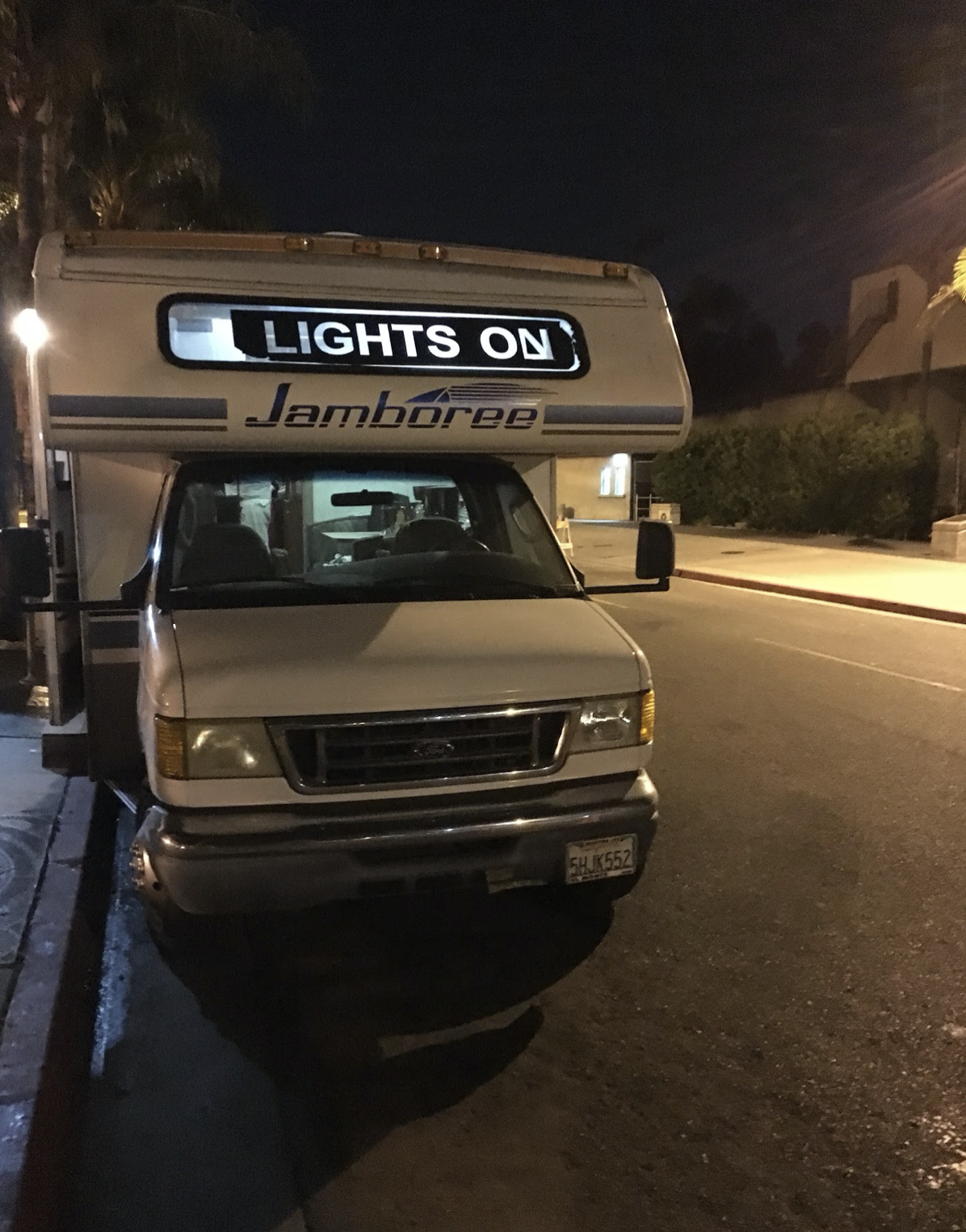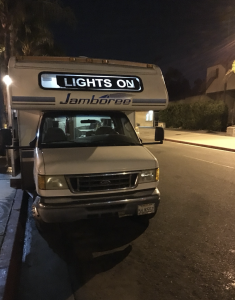
Editor’s note: This story was reported and written in the Fall of 2018. We have preserved the original story for the integrity of the piece. The Sheriffs Department of Santa Ana has transitioned to releasing inmates at 8am now.

In the dim orange light of a nearby parking structure, the unnamed road between Boyd Way and Flower Street in downtown Santa Ana, California, bustled with activity. Countless high school students, the remains of a football game that just ended nearby, milled about outside, laughing and celebrating their team’s win. But at the end of the block, the activity on Sixth Street was quiet. There, two formidable gray buildings loomed. On the left was the Central Women’s Jail for Orange County, on the right the Central Men’s Jail and the Intake Release Center, the county’s processing complex for the newly incarcerated. The central hub of the nation’s ninth largest jail system was just down the street.
As the youngsters dispersed into the night, a twenty-two-foot RV rumbled down the road, pulled over, and parked. In the window above its windshield, white letters on a black background spelled out “LIGHTS ON.” As soon as the RV parked, volunteers scurried around it setting up folding chairs and plastic tables, turning on the generator, dropping off donations, preparing boxes of food for distribution, and filling a carafe with steaming coffee. The volunteers set up two folding tables: on the first was a metal clipboard and the coffee, creamer, and sugar, and on the second, enormous cardboard boxes, piled high with donated danishes, muffins, and bags of chips.
It’s 10:41 p.m., and the Lights On RV is ready for the night ahead.
Lights On is an RV-operated reentry program dedicated to the immediate needs of people released from Orange County’s Central Jail Complex. The reentry program provides food, coffee, clothing, access to telephones, and, sometimes, transportation and housing. For years, the RV operated during the time that the vast majority of people were released from jail, Monday through Friday from 9:30 p.m. to about 3:30 a.m.—a six-hour period in the middle of the night; that was until Orange County Sheriff Don Barnes altered jail policy to release people at 8 a.m. in 2019. Most people were released from Orange County jails at night because jail time is usually counted as a number of days; once an incarcerated person has spent time in jail that day, including time in wee hours of the morning, they can be released as if they had spent the whole day in jail. From the RV, the program serves on average 40 to 50 people per night, although, as one volunteer noted, they once maxed out at 110. So long as someone writes their name and city of residence on the clipboard at the end of the table, anyone who passes by the RV can receive services from the program, whether or not they’ve just gotten out of jail.
The Lights On program was founded in 2004 as a “special work” by the Society of Saint Vincent de Paul, an international Catholic society dedicated to serving the less fortunate through basic needs assistance. Saint Vincent de Paul’s new Orange County Chapter President, Brigid Noonan, explained that the biblical basis for the Society’s programs comes from Jesus’ words in Matthew 25:40, “Whatsoever you do to the least of my brethren, you do unto me.” Since its founding, the Society has been dedicated to assisting “the least of [Jesus’s] brethren”—the impoverished, the hungry, the homeless, the sick, and the poor—and, today, one of their main projects is serving the recently released from the Lights On RV outside the Santa Ana Jail.
However, Lights On is a joint effort between the Society of Saint Vincent de Paul and Micah’s Way, an Orange County-based non-profit that focuses on satisfying the immediate needs of people experiencing poverty or homelessness. Denis Clarke, the Executive Director of Micah’s Way, explained that the Lights On program has two main functions: to keep recently released people safe at night in a neighborhood with drugs, gangs, and police activity, and to refer people to other services in the community.
At 11:30 p.m., five Lights On volunteers gathered around the folding tables on the sidewalk outside the RV. They bantered and swapped stories with each other; some smoked the cigars that someone else had recently purchased at a Micah’s Way benefit auction. Someone cracked a joke about California’s Prop 47, a recent sentencing reform bill, and laughter reverberated in the night air.
Empty space was practically nonexistent a few feet away, inside the RV. Two coffee pots bubbled on the table, boxes of food and bottles of beverages filled the shelves and counters, and clothing donations piled four-feet-high in the back bedroom. Every surface and corner was filled with the vast amount of goods that the volunteers need to run this program. Colin, a younger, bearded man and one of the main managers of the RV, wore a honey-colored rosary as he was at ease among the piles of equipment. Colin was in charge of the day-to-day running of the truck, which included making coffee, handing out clothing donations, and determining when to offer someone housing for the night. Colin’s leadership makes a lot of sense; he handles everyone—from the volunteers to the people approaching the RV—compassionately but pragmatically. He got his start outside the jail as a bail bondsman in hopes that he could help people, but it didn’t work out that way. “If you really wanna help people,” Colin explained, “[Lights On] is where it’s at.”
The Orange County Jails are a network of five jail facilities, all of which are overseen by the Orange County Sheriff’s Department. The Central Men’s and Central Women’s Jails are housed in two concrete buildings in downtown Santa Ana, along with the Intake Release Center, the place where new arrivals are processed. Slightly north, in Orange, the Theo Lacy Jail Facility houses males (and transgender women). Southeast, in Irvine, the minimum security James A. Musick Facility housed both men and women, prior to closing for renovations in 2019.
The Orange County Sheriff’s Department and the jails they run have long been embroiled in scandal. In 2014, one of the largest criminal justice scandals in California’s history, a plan between the District Attorney’s office and the Sheriff’s Department to house known jail informants with high-profile inmate targets for easily incriminating information mired the department and derailed criminal cases. Several Orange County Sheriffs are similarly surrounded by controversy. In 2008, Sheriff Mike Carona was federally indicted on corruption charges. Sheriff Carona’s successor, former sheriff Sandra Hutchens was involved in the 1980 fatal shooting of a man and the injury of two children, resulting in a wrongful death lawsuit against her department and a judicial verdict that $1.3 million in damages be paid to the victims’ family, the single largest police misconduct payout in California at the time. Current Sheriff Don Barns has also been accused of misconduct. In the Fall of 2019, internal auditors condemned Barnes’ department for booking key pieces of evidence that included drugs, cash, photos, and videos, a malpractice that could jeopardize thousands of criminal convictions. The Orange County Jails themselves are under investigation by the American Civil Liberties Union, investigative journalists, and, until 2019, the California Attorney General for mistreatment of incarcerated people and deputy misconduct. When people are spit out of this system, Lights On is there.
The pace at the Lights On RV usually slows down between 12:30 and 1:15 a.m.. During that time, a few homeless individuals shuffle past, sign their names, and take some food, but the steady flow of people approaching the RV from the jail complex down the block thins to almost nobody. The night I spent at the RV was no different; after a short, grey-haired man left in his cab, no one approached the RV for almost an hour. Johnny Villaseñor, another volunteer, said that this daily slowdown is the result of a correctional officer shift change inside the jail. During shift change, no one can leave.
Finally, at 1:23 a.m., three young men approached the RV. All three were from James A. Musick Facility, which busses people to the Main Jail Complex for release. One of the three men, an eighteen-year-old named Vincent Lucas, was missing pants and shoes, and instead wore half of a jail-issued white jumpsuit and socks. Most of his clothes were taken for evidence, Vincent explained. He had been in jail for six months.
Before the men could sign their names on the clipboard, Colin asked Vincent what size pants he wore and disappeared into the RV to rummage through the pile of donated clothes inside. All three signed their names on the clipboard and accepted coffee with cream and sugar along with some snacks,politely asking for each snack as they reached for another danish or bag of chips. They asked if the RV gave out cigarettes, but Johnny replied that they don’t anymore. The men gave their phones to volunteers for charging, but because the RV’s generator charges cell phones so slowly and Vincent’s phone hadn’t been used in six months, they used the RV’s phone to call a ride. Eventually, Colin emerged from the RV with a pair of blue slacks to replace Vincent’s half-jumpsuit. Vincent refused to change in front of the two women at the RV —“out of respect,” he said—and, instead, he asked his friends to line up around him to construct a makeshift changing room.
After Vincent had changed, I asked him and his friend Christian Carrillo, a twenty-three-year old who was also just released, about the effects of the Lights On program.
“It’s a great idea,” Vincent said, “and very helpful for people that are…”
“People like us?” Christian offered, jokingly.
Vincent corrected him, “People that are unfortunate right off the bat, you know? It gives them a little head start, a little bit of hope.”
As the three men took off in a friends car a few minutes later, they voiced a chorus of “Thank you’s” and “God bless you’s” to the Lights On volunteers and advised that the RV start carrying cigarettes again.
At 2:02 a.m., Colin said that one of his regulars, a homeless man nicknamed Jimbo, had arrived at the RV. Although the program is primarily geared towards people released from jail, the RV will happily help anyone who signs their check-in sheet, so long as they don’t loiter too long. If someone needs a place to stay, Lights On can arrange it; Colin has beds reserved every night at The Courtyard, a shelter a few blocks away. He hands out his business card sparingly, but assures that, should someone arrive at The Courtyard with his card in hand, they’ll be offered a safe place to sleep. If someone is looking for food, Lights On will gladly give out coffee and snacks, as they did for Jimbo that night. After he signed his name and surveyed the table, Jimbo accepted a cup of coffee and gingerly took some food. Colin grabbed a plastic bag from the RV, gave it to Jimbo, and told him to “stock up.” Jimbo required some persuading, so Colin showed him the extra box of food the RV had to last the night. Satisfied with the amount of food left for everybody else, Jimbo funneled pastries into the bag.
“God bless you,” Jimbo said as he walked away from the RV.
God bless you. God bless you. God bless you. The phrase rang out almost every time somebody left Lights On, those three words harmonizing with the gentle hum of the RV’s generator.
Colin retrieved a candle from the RV and lit it. The scent of caramel filled the cold air.
At 2:25 a.m., a blond woman arrived on a bicycle. She picked through the food on the table, dissatisfied with what the RV had to offer. She asked for her danish to be heated up; Colin obliged and fired up the RV’s microwave. When Colin returned with her newly-warmed danish, she spurned it and said it was stale. Colin assured her that they were all fresh. Johnny asked, joking, if she wanted ice in her coffee, too. She did.
The woman took several danishes and scones, unwrapped them, and left the wrappers in a pile on the table. Colin and Johnny told her that there was a trash can at the end of the table, about four feet away, and asked her to throw away the wrappers there. She’d do that eventually, she said. Johnny and Colin grew anxious as she piled more and more trash on the table. But at last, she grabbed the pile and deposited it in the bin. She wished the volunteers well and biked away.
The blond woman wasn’t particularly satisfied with what the RV could offer. She knew that all of her troubles could not be made okay with a cup of coffee, a danish, and some smiling volunteers. She knew that there are bigger problems here, that a thousand compounding problems—homelessness and corruption and violence and drug abuse and so many more—skulk in the shadows of the streets of downtown Santa Ana each night. These problems plunge more and more people into systems like the Orange County Jails, which is riddled with misconduct and intended to break the human spirit. Solutions rarely appear, and those that do are seldom, if ever, employed. Nothing can make that okay.
But sometimes, it’s nice to forget that nothing can make that okay over a cup of coffee and a danish. So volunteers give up their energy and their night’s sleep, local organizations donate clothes and coffee and food, and gracious people come to participate in the program and accept these donated things. Everything is not okay, but at least the coffee is good and hot.
Margaret O’Hara is a Literary Journalism and Criminology, Law, and Society double major. She is particularly interested in journalism and activism surrounding the criminal justice system. You can contact Margaret at [email protected].


Editor's picks
Very well written and intriguing piece. You have a beautiful way of telling a story while educating your audience!